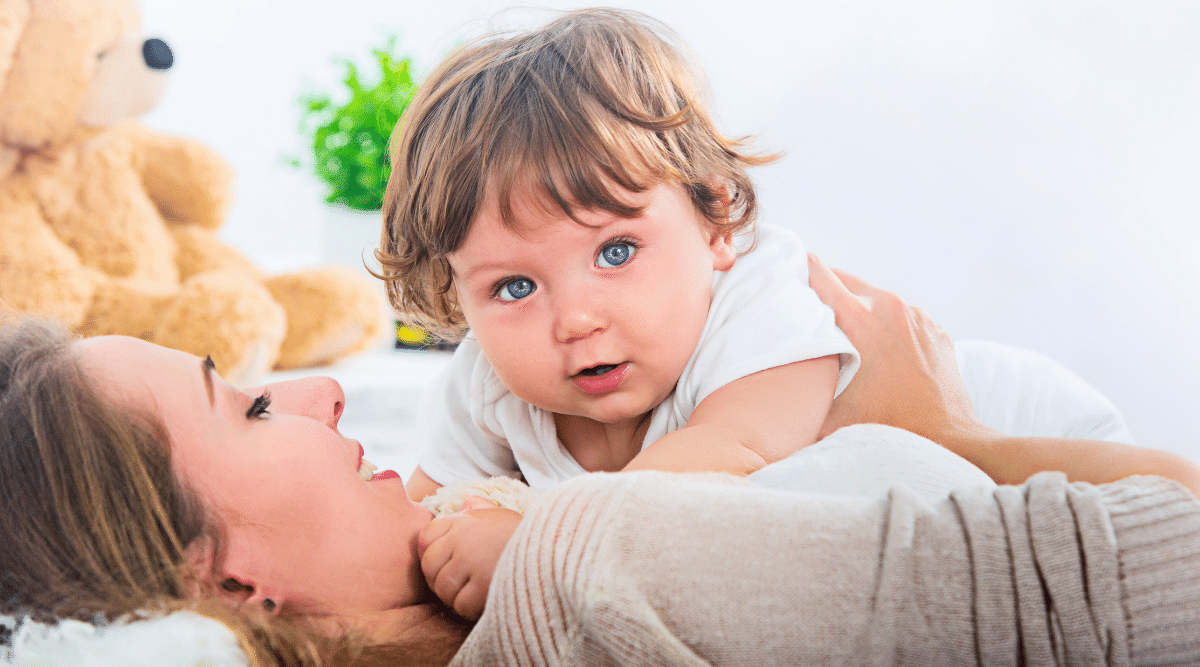We have many tools to help raise our babies in our modern lifestyles. Some toys and equipment help their physical development, but others can get in the way. Plus, what about mum and dad being baby’s favourite toy? Guiding us through this minefield is Nicole Pates, spokesperson for the Australian Physiotherapy Association.

Are there particular ways for moving babies from A to B, whether it’s your arms, a carrier or a stroller, that are better for their development?
Babies’ development responds to stimulus – how you carry them, how you hold them, where you take them, the environment. And variety (with repetition) in those environments are incredibly powerful stimuli for development.
When the “back to sleep” campaign came in [which prevents sudden unexpected death in infancy], all the babies spent much of their time on their back asleep. But, in addition, they spent a lot of time on their back throughout the day. And they were lacking in variety.
Babies are born with lovely soft mouldable skulls to come out of mummy’s tummy, and ‘back time’ ends up flattening the skull and changing the head shape. This change makes it harder for the baby to move because they’re trying to move over a bump. So to combat the head flattening, they introduced tummy time.
Some babies are genetically not as good at tummy time, reflux, or other issues, and parents say they hate tummy time; it’s highly stressful. But, carriers and the different ways you can hold and move babies are powerful in stimulating the motor development system and learning.
So would you say, to give them that variety of stimuli, you would mix it up?
I always say variety is the spice of life. The more you mix it up and the more variety in the way you hold, carry, move, feed and play with your baby, the more exposure they have [to different stimuli] and the more likely they are to develop their motor skills.
For those babies who are not a fan of tummy time, do you have some favourite tricks to make it more enjoyable?
Tummy time is about head control and strength. So often, when babies don’t like tummy time, I shift the focus from being on the floor and more to head control and social interaction.

To put it in lay terms, rather than worrying about putting your baby on the floor, can you hold them in tummy time, for example, when you carry them?
When you pick them up, introduce some rotation – rather than picking them up like a pancake, pick them up through the side and help develop head control?
Let your baby sit in your lap with lots of eye contact and “face time” for social interaction and connection?
There has to be a reason why your baby wants to do tummy time. Toys are okay, but their favourite toy is you. So if they’re finding it difficult, can you get eye level with bub? To do that a bit more easily, often an incline helps – with the baby on your chest, or do tummy time on the changing table after you’ve changed their nappy.
Shift the focus off tummy time and minutes – let’s work on understanding your baby’s cues. What are their early distress signals? If they’re starting to get fidgety and starting to tense, let’s roll them off their tummy. So they know that you’re responding and feel safe to give it more of a go next time.
Even being in the carrier counts as tummy time because they’re off their back.
Are there modern parenting accessories like jolly jumpers or baby walkers that are not such a great idea (for bub’s development)?
A Bumbo or standing frame doesn’t aid development – consider them helpful things to give you 10 minutes free to have a coffee here and there.
There are certainly developmental stages and situations where using “containers” is safer.
A baby’s hips and muscle system continues to develop after birth. So if you’re standing them in containers like jumpers or standing frames before 6 months, their hips are still immature, and they don’t have the core strength to hold themselves up. But we’re putting them in a standing position.
So I always say to people try to avoid standing them until they can pull to stand themselves. Then, if you’re going to use it, try to use it for 10 minutes, irregularly, for ‘you time’.
My favourite container is a playpen or washing basket. Putting the baby in the washing basket is a great excuse not to do the washing! You can sit them in the washing basket with clothes around them from about 4 months or when they’re confident in tummy time.
However, the walkers with the wheels on the bottom are not safe and not recommended by the Physio Association because the wheels can get caught.

What is the most important thing you’d like new parents to know about supporting their baby’s normal development in the first few months?
Connection before correction. You don’t have control over making babies roll or move. Development is super cool because it’s not only about the muscle system but also about the visual system, the sensory system and the brain; how they integrate.
For example, around 5 to 6 months, the visual system changes from 2D to 3D, which helps babies with reaching and depth perception. Rolling is triggered by reaching and reaching across the body. So, they may have the muscle strength to roll but not be moving yet because their vision system hasn’t gone through that little leap. Plus, you can’t force brain development to occur. All you can do as a parent is connect with your child and see all the little mini-milestone magic that happens.
So you notice your baby reaching and providing play opportunities in line with their development. Connect with them, read their little cues, and find what makes them tick.
Focusing on mini-milestone magic rather than the big milestones is something that I try to emphasise.
The amazing thing is that babies all have a unique developmental trajectory – there’s a range of normal. So what you want to see is that they’re continuing to gain skills.
Nicole’s suggested resources:
- Child health nurses
- Your GP
- Raising Children Network
- Baby Play Academy
Nicole Pates is a spokesperson for the Australian Physiotherapy Association and director of Western Kids Health, Perth. For more advice, follow @nicole_kidsphysio
Published 26th March 2022


Baby carrying is wonderful and it’s lovely to see babies carried heart to heart facing mother when little and heart to back as they get older. Babies are not neurological developed to face the world face to face for extended times until the are able to stand by themselves. By this stage they are too big to be face to face in a carrier and travel best on your back. I am most uncomfortable seeing babies facing outwards and dangling in baby slings often without any other physical contact . The baby is wired to be carried facing the mother in the frog position which provides optimum support for its hips and back. The smell of her and the sound/resonance of her voice provides optimum stimulation for security and neurological development. This closeness also stimulates breast feeding. All part of natures divine design to ensure that the race continues to develop to its full potential. I know that fathers are often the ones using the carriers and this increased involvement of dads is a welcome one. However it is not unusual to see the dads distracted with their phones and the babies left dangling facing outwards. Neither which provides the support required by the little one.
People will say that the babies ‘like’ it and short exposure say 10mins may be fine but they become overwhelmed by too much input and need to protect themselves by glazing over. When facing inwards they can and do sleep when they need to. Happy baby carrying!